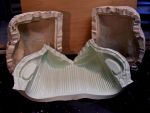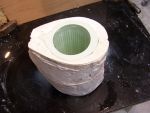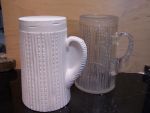Silicone Rubber Mold

How a silicone rubber "glove" mold is made.
A glove mold is composed of two parts: a thin skin of rubber, which is the casting surface, and a plaster shell, or "mother mold", which supports the rubber liner.
In use, the rubber picks up fine detail, forgives undercuts, and allows for clean casting of many materials. The plaster shell holds the rubber rigidly in place, so the overall form is maintained. This system also uses a minimum of rubber, which is costly.
Such molds are used for casting a variety of materials- plaster, cement, urethane resins, wax (for lost-wax casting of metal or glass) and even food products.
This technique is commonly used in sculpture casting. I learned the process from Neil Fryzer, who had wide experience working in sculpture casting shops and at the Museum of Natural History.
This project was for Steuben Glass. The factory needed an expendable reproduction of this cut glass pitcher, to use as a model for the glassblowers and cutters to follow.
Here is the process:
The piece is set upside-down on a base plate.
The piece is wrapped to protect it.
A thin blanket of clay is modeled around the piece.



Thin metal shims are installed to create the seam line in the plaster.
A plaster shell is laid up.
The plaster shell is opened, cleaned up, and prepared.
Clay is removed from the model



The shell is reassembled. Rubber is weighed, mixed and poured in. This fills the void created by the absence of the clay.
After the rubber has set, the two plaster shells are separated. The rubber mold cut as needed and removed.



Rubber mold is ready to receive plaster.
The original and the plaster copy.



To expand, click images below:
Click the images below to enlarge













Categories
Commercial Projects
Studio, Tools, Techniques
Mold Design
Elements in the design of plaster molds for slip-castingNotes on Ceramics and Design
From the Collection
Objects of interest, mostly ceramic, each with a story to tell.DM Artwork: Ceramics
DM Artwork

Shop Talk Archives
December, 2023
September, 2023
October, 2021
February, 2020
January, 2020
April, 2016
December, 2015
January, 2015
June, 2014
April, 2014
March, 2014
June, 2013

Recent Shop Talk
Eva Zeisel, a personal chronology
I attempt to reconstruct two decades of work with Eva Zeisel
Eleanor
Eleanor Plates
New plates 8/2023
New ceramic work
Small-batch production
I often get inquiries regarding small-batch ceramic production.
Fish Plates
Hauling in a net full of fish plates
View More Shop Talk